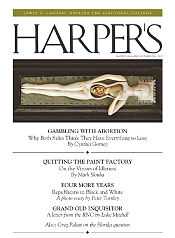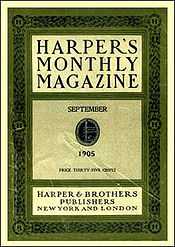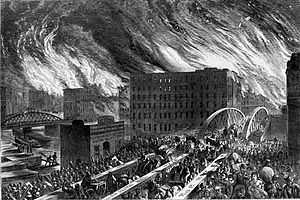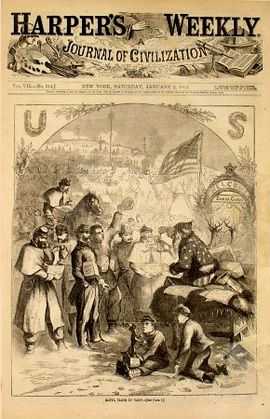Harper's Magazine
 November 2004 issue | |
| Editor | Ellen Rosenbush |
|---|---|
| Categories | Art, culture, literature |
| Frequency | Monthly |
| Total circulation (December 2013) | 186,839[1] |
| First issue | 1850 |
| Company | Harper's Magazine Foundation |
| Country | United States |
| Based in |
666 Broadway New York City |
| Language | English |
| Website | www.harpers.org |
| ISSN | 0017-789X |

Harper's Magazine (also called Harper's) is a monthly magazine of literature, politics, culture, finance, and the arts. Launched in June 1850, it is the second-oldest continuously published monthly magazine in the U.S. (Scientific American is the oldest). The current editor is Ellen Rosenbush, who replaced Roger Hodge in January 2010. Harper's Magazine has won many National Magazine Awards.[2]
History
Harper's Magazine was launched as Harper's New Monthly Magazine in June 1850, by the New York City publisher Harper & Brothers; who also founded Harper's Bazaar magazine, later growing to become HarperCollins Publishing. The first press run, of 7,500 copies, sold out almost immediately; circulation was some 50,000 issues six months later.[3]
The early issues reprinted material pirated from English authors such as Charles Dickens, William Make-peace Thackeray, and the Brontë sisters.[4] The magazine soon was publishing the work of American artists and writers, and in time commentary by the likes of Winston Churchill and Woodrow Wilson. The first appearance in print of portions of Moby Dick occurred in the October 1851 issue of Harper's under the title, "The Town-Ho's Story" (titled after Chapter 54 of Moby Dick).[5]
In 1962, Harper & Brothers merged with Row, Peterson & Company, becoming Harper & Row (now HarperCollins). In 1965, the magazine was separately incorporated, and became a division of the Minneapolis Star and Tribune Company, owned by the Cowles Media Company.
In the 1970s, Harper's published Seymour Hersh's reporting of the My Lai Massacre. In 1971 editor Willie Morris resigned under pressure from owner John Cowles, Jr., prompting resignations from many of the magazine’s star contributors and staffers, including Norman Mailer, David Halberstam, Robert Kotlowitz, Marshall Frady and Larry L. King:Morris’s departure jolted the literary world. Mailer, William Styron, Gay Talese, Bill Moyers, and Tom Wicker declared that they would boycott Harper’s as long as the Cowles family owned it, and the four staff writers hired by Morris—Frady among them—resigned in solidarity with him.”
Robert Shnayerson, a senior editor at Time magazine, was subsequently hired to replace Morris as Harper's ninth editor, serving in that position from 1971 until 1976.[7][8]

Lewis H. Lapham served as managing editor from 1976 until 1981; he returned to the position again from 1983 until 2006. On June 17, 1980, the Star Tribune announced it would cease publishing Harper's Magazine after the August 1980 issue; however, on July 9, 1980, John R. MacArthur and his father, Roderick, obtained pledges from the directorial boards of the John D. and Catherine T. MacArthur Foundation, the Atlantic Richfield Company, and CEO Robert Orville Anderson to amass the one-and-a-half million dollars needed to establish the Harper's Magazine Foundation that currently publishes the magazine.[9][10]
In 1984, Lapham and MacArthur—now publisher and president of the foundation—along with new executive editor Michael Pollan, redesigned Harper's and introduced the "Harper's Index" (ironic statistics arranged for thoughtful effect), "Readings", and the "Annotation" departments to complement its fiction, essays, reportage, and reviews. As of the March 2011 issue, contributing editor Zadie Smith writes the print edition's New Books column.
Under the Lapham-MacArthur leadership, Harper's magazine continued publishing literary fiction by the likes of John Updike, George Saunders, and others. Politically, Harper's was an especially vocal critic of U.S. domestic and foreign policies. Editor Lapham's monthly "Notebook" columns have lambasted the Clinton and the George W. Bush administrations, and, since 2003, the magazine has concentrated on reportage about U.S. war in Iraq, with long articles about the battle for Fallujah, and the cronyism of the American reconstruction of Iraq. Moreover, other stories have covered abortion, cloning, and global warming.[11]
In 2007, Harper's added the No Comment blog, by Scott Horton, about legal controversies, Central Asian politics, and German studies. In addition, in April 2006, Harper's began publishing the Washington Babylon blog in its site,[12] wherein Washington Editor Ken Silverstein wrote about corrupt American politics; and in 2008, Harper's added the "Sentences" blog, by contributing editor Wyatt Mason, about literature and belle lettres; both Silverstein's and Mason's blogs have since ceased publication. Another website feature, composed by a rotating set of authors, is the Weekly Review, single-sentence summaries of political, scientific, and bizarre news; like the Harper's Index and "Findings" in the print edition of the magazine, the Weekly Review items are humorously and ironically arranged.
Controversies
Lewis H. Lapham was criticized for his reportage of the 2004 Republican National Convention, which had yet to occur, in his essay "Tentacles of rage: The Republican propaganda mill, a brief history," published in the September 2004 issue. He apologized in a note.[13][14]
The March 2006 issue contained the Celia Farber reportage, Out of Control: AIDS and the Corruption of Medical Science, presenting Peter Duesberg's theory that HIV does not cause AIDS.[15][16] It was strongly criticized by AIDS activists,[17] scientists,[18] the Columbia Journalism Review,[19] and others, as inaccurate and for promoting a scientifically-discredited theory.[20] The Treatment Action Campaign, a South African organization working for greater popular access to HIV treatments, posted a response by eight researchers documenting more than fifty errors in the article.[21]
Notable contributors
Gallery
-

Thomas Nast immortalized Santa Claus with an illustration for the January 3, 1863 issue
-

Harper's Magazine, June 1896, by Edward Penfield
-

Harper's Magazine, May 1897, again by Penfield
See also
References
- ↑ "eCirc for Consumer Magazines". Alliance for Audited Media. December 31, 2012. Retrieved June 21, 2013.
- ↑ Awards and Honors (PDF) at Harper's site
- ↑ History of Harper's (PDF) on Harper's site
- ↑ "Gale Encyclopedia of U.S. History: Publishing Industry". answers.com. Retrieved 2013-02-13.
- ↑ Moby Dick
- ↑ Scott, Sherman (Nov/Dec 2007). "The Unvanquished". Cjr.org. Retrieved 2012-05-16.
- ↑ Monday, June 28, 1971 (1971-06-28). ""The Press: New Head at Harper’s," ''TIME'' magazine, June 28, 1971". Time.com. Retrieved 2012-05-16.
- ↑ "''Harper's Magazine,'' "About This Issue," September 1971". Harpers.org. Retrieved 2012-05-16.
- ↑ Facts on File 1980 Yearbook, pp.501, 582
- ↑ Woo, Elaine (2007-12-05). "Arco founder led firm into major civic philanthropy". Los Angeles Times. pp. B6
- ↑ An American Album: One Hundred and Fifty Years of Harper's Magazine, a 712-page illustrated anthology, with an introduction by Lewis H. Lapham and a foreword by Arthur Schlesinger Jr.
- ↑ http://harpers.org/index.html
- ↑ Shafer, Jack. "Lewis Lapham Phones It In: Figuring out what's wrong with Harper's magazine." Slate 15 September 2004.
- ↑ Lapham, Lewis H. "Tentacles of rage: The Republican propaganda mill, a brief history." Harper's September 2004. pp. 43–53.
- ↑ Farber, Celia (2006-03-01). Out Of Control, AIDS and the corruption of medical science. Harper's Magazine. Retrieved 2006-03-13.
- ↑ Miller, Lia (2006-03-13). An Article in Harper's Ignites a Controversy Over H.I.V.. The New York Times. Retrieved 2006-03-13.
- ↑ Farber Feedback. POZ Magazine. Retrieved 2006-03-13.
- ↑ Letters from scientists and physicians criticizing Harper's for poor fact-checking of Celia Farber's article on AIDS. Accessed 21 Oct 2006. Archived August 12, 2006 at the Wayback Machine
- ↑ Harper's Races Right over the Edge of a Cliff, by Gal Beckerman. Published in the Columbia Journalism Review on March 8, 2006. Accessed June 14, 2007.
- ↑ Kim, Richard (2006-03-02). Harper's Publishes AIDS Denialist. Retrieved 2006-03-13.
- ↑ Gallo, Robert; Nathan Geffen, Gregg Gonsalves, Richard Jeffreys, Daniel R. Kuritzkes, Bruce Mirken, John P. Moore, Jeffrey T. Safrit (2006-03-04). Errors in Celia Farber's March 2006 article in Harper's Magazine (PDF). Treatment Action Campaign. Retrieved 2006-03-13.
External links
- Harper's website
- Library of Congress collection, searchable text of magazine from 1850 to 1899 with links to scanned pages.
- Hathi Trust. Harper's New Monthly Magazine, digitized issues
- "Book and Periodical Illustration [in America, 1820–1870." American History through Literature, 1820–1870. Ed. Janet Gabler-Hover and Robert Sattelmeyer. Detroit: Charles Scribner's Sons, 2006. 144-48.
- NYPL Digital Gallery. Illustrations from Harper's Magazine, various dates
| Wikimedia Commons has media related to Harper's Magazine. |
| ||||||||||||||||||||||||||||||||||||||||||||||||||||||||||||||||||